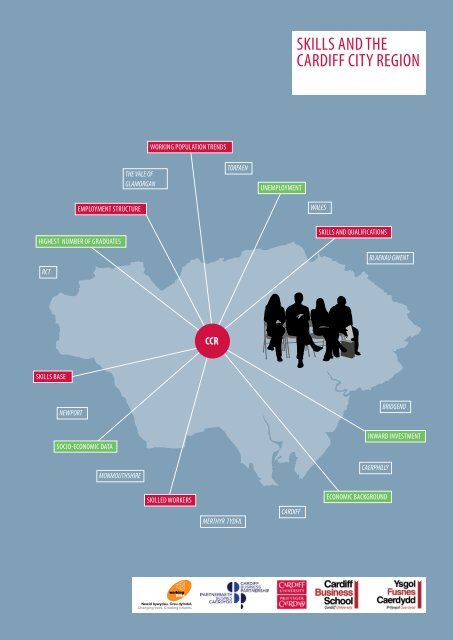SKILLS AND THE CARDIFF CITY REGION - Working Links
SKILLS AND THE CARDIFF CITY REGION - Working Links
SKILLS AND THE CARDIFF CITY REGION - Working Links
You also want an ePaper? Increase the reach of your titles
YUMPU automatically turns print PDFs into web optimized ePapers that Google loves.
8 Skills and the Cardiff City RegionCardiff Business School 92. ECONOMIC BACKGROUND TO <strong>THE</strong> <strong>SKILLS</strong> ANALYSIS Cont.2.2 Employment2.2.1 Table 3 reveals the distribution of the Cardiff City Regionemployment across the 10 constituent local authorityareas. The region encompasses nearly 50% of total Welshemployment. This is to be expected as it accounts forapproximately 50% of the Welsh population. Around one thirdof employment in the CCR is within the Cardiff local authorityarea. Table 3 also reveals the intensity of employment withinTable 3: Employment across CCR Local Authorities 2011the local authorities. It measures the share of the Welshpopulation in the local authority compared to the shareof employment in the local authority. For example, Cardiffhas 16.4% of Welsh employment with 11.2% of the Welshpopulation. If a local authority has a score greater than oneit indicates it has a high intensity. These data shows theimportance of Cardiff and Newport as employment hubsfor the city region.2.2.2 Table 4 provides more detail and shows recent changesin employment for CCR local authorities for the period2008-2011. It should be noted that changes in employmentcan be affected by the time-scale adopted. This analysisaims to investigate whether employment in the individuallocal authorities is recovering after the problems of thecredit crisis.Overall employment in Wales fell by 2.1% between 2008and 2011. Although no local authorities saw growthacross the period selected, Table 4 does reveal somelimited recovery in employment in the Cardiff City Region as awhole after 2009. At the same time, the table provides strongevidence of a variation in prospects across the CCR. Taking theshorter period 2009-2011 from Table 4, Bridgend and Monmouthsee large losses of employment, while stronger growth innumbers is evidenced in Cardiff and Newport. It is important torecognise that employment growth in Cardiff and Newport ofteninvolves people outside of these two local authority areas, withCardiff particularly seeing strong inward commuting from localauthority areas to the North and West.Source: Business Register and Employment Survey (ONS)KEY Employment % of Wales Total Intensity of EmploymentTable 4: Employment across CCR Local Authorities 2008 to 2011Note: Numbers are for those aged 16 and over. Source: Business Register and Employment Survey (ONS)1.5 %4.4 %4.2 %16.4 %+10+2+H +8+2+H +32+4+H0.71.00.7employmentemploymentemployment18,129 51,871 49,458 191,929+3+2+Hemployment1.5Total EmploymentWales20081,195,52020091,157,74920101,165,52020111,170,0772008-2011% Change-2.12008-2011% Change0.4Blaenau GwentBridgendCaerphillyCardiffBlaenau Gwent19,03418,06218,99118,129-4.8-4.5Bridgend56,94755,35453,34451,871-8.9-2.81.9 %2.7 %6.2 %6.2 %+6+2+H +14+4+H +13+2+H0.80.91.3employmentemploymentemployment22,283 31,208 72,486 72,363+4+2+Hemployment0.8CaerphillyCardiffMerthyr Tydfil50,727193,71022,33451,552187,73221,87448,887190,69221,85949,458191,92922,283-2.5-0.9-0.21.20.61.9Merthyr TydfilMonmouthshireNewportRCTMonmouthshireNewport35,58273,86433,31069,86232,49670,75031,20872,486-12.3-1.9-4.02.53.1 %2.9 %49.6%+6+2+H +50+2+H +100+H0.81.0employmentemployment36,434 33,688 579,849 1,170,077employment1.0+7+2+HemploymentRCTThe Vale of GlamorganTorfaenCCR73,27636,66135,150597,28570,39035,97233,333577,44172,43535,68733,457578,59872,36336,43433,688579,849-1.3-0.6-4.2-2.9-0.12.10.70.2The Vale of GlamorganTorfaenCCRWales
10 Skills and the Cardiff City RegionCardiff Business School112. ECONOMIC BACKGROUND TO <strong>THE</strong> <strong>SKILLS</strong> ANALYSIS Cont.2.2.3 There has been a concern in South East Wales as a wholethat selected employment increases reflect highernumbers of part-time opportunities, and a possiblereduction in the quality of employment. To understandthe nature of the changes in employment, comparisonsare made between the changes in part time and full timework across the period.2.2.4 Table 5 displays these data. Overall across the Cardiff CityRegion the level of part-time employment is actuallylittle changed over the period with the exception of apeak in 2010.Table 5: Part Time and Full Time Employment across CCR Local Authorities 2008 to 20112.2.5 However, Table 5 reveals that full time employment inthe CCR fell by around 22,000 over 2008-2010, butsaw some recovery in 2011. There is little evidenceof a general trend that would hint at a strong overallincrease in part time working. Again interpretationhere is sensitive to the reference year taken, but in fivelocal authorities there is evidence to demonstrate thatpart-time employment increases marginally in theperiod 2008-11. Three areas (Caerphilly, Monmouth andBridgend) see sharp falls in part-time working over theperiod 2008-11.2.2.6 Covering both semi-rural and urban areas, the economicbase of the Cardiff City Region was built on the oldmanufacturing and extractive industries. This focus haschanged over the last three decades. Studies in thelast decade have revealed that the growth of services,particularly in the public sector, has dominated economicactivity. Table 6 shows the changes in public and privatesector employment across the more recent period2008-11 after the credit crunch.2.2.7 Table 6 reveals that there are significant differences in thechanges in public and private sector employment. Themajority of public sector employment is within theeducation, health and public administration sectors.For the whole of the Cardiff City Region, employment inthe public sector grew in 2008-09. By 2011 public sectoremployment stood at around 166,000, 0.6% higher thanit had been in 2008. Table 6 confirms that up until 2011 thenon-market sector of the Cardiff City Region was providingsomething of a mask concealing private sector employmentlosses. For example Table 6 reveals nearly 27,000 private sectorjob losses in the Cardiff City Region between 2008-09 withsome limited recovery in 2010 and 2011.Once again the data identify some of the variation acrossthe Cardiff City Region. In terms of changes in public sectoremployment, Bridgend, Caerphilly and Monmouthshire haveseen relatively high losses, compared with stronger gains inCardiff and Newport. Cardiff has seen over a 10% rise in publicsector employment between 2008-11, whereas Monmouthshiresaw a fall of over 16%. With the exception of Caerphilly and RCT,there has been a fall in private sector employment in all localauthorities between 2008-11.Source: Business Register and Employment Survey (ONS)`Table 6: Changes in Public and Private Sector Employment across CCR Local Authorities 2008 to 2011Total EmploymentBlaenau GwentBridgendCaerphillyCardiffMerthyr TydfilMonmouthshireNewportRCTThe Vale of GlamorganTorfaenCCRFulltime12,83939,15533,385133,46914,84021,98050,07353,12623,52823,845406,2402008Parttime6,19517,79317,34260,2407,49413,60323,79220,15013,13311,304191,046Fulltime11,79536,66834,079130,20714,48621,53446,93146,71122,67721,828386,9162009Parttime6,26818,68617,47357,5257,38811,77622,93123,67813,29511,504190,524Fulltime11,78635,27033,195129,54314,71720,67147,45948,37622,20220,994384,2132010Parttime7,20518,07515,69261,1487,14211,82423,29224,06013,48512,463194,386Fulltime11,39135,82033,982130,24215,35220,03450,01947,47522,10221,880388,2972011Parttime6,73816,05115,47561,6876,93311,17522,46724,88714,33111,808191,552% ChangeFull Parttime time-11.3-8.51.8-2.43.5-8.9-0.1-10.6-6.1-8.2-4.48.8-9.8-10.82.4-7.5-17.8-5.623.59.14.50.3Note: Numbers are for those aged 16 and over. Source: Business Register and Employment Survey (ONS)Total EmploymentBlaenau GwentBridgendCaerphillyCardiffMerthyr TydfilMonmouthshireNewportRCTThe Vale of GlamorganTorfaenPublicSector5,45916,96213,95846,5468,5339,16920,54822,6029,92911,0432008PrivateSector13,57539,98536,769147,16413,80126,41453,31650,67426,73224,106PublicSector5,84916,73115,15750,2488,8027,93323,21122,52510,20011,1252009PrivateSector12,21338,62336,395137,48313,07225,37746,65147,86525,77222,208PublicSector5,96417,18911,99249,9078,7647,80422,80023,29110,03612,0092010PrivateSector13,02636,15536,895140,78513,09524,69147,95049,14525,65121,448PublicSector5,43515,68412,63651,4668,6327,67021,48421,36310,28211,0742011PrivateSector12,69436,18836,822140,46213,65123,53951,00350,99926,15122,614% ChangeFull Parttime time-0.4-7.5-9.510.61.2-16.34.6-5.53.60.3-6.5-9.50.1-4.6-1.1-10.9-4.30.6-2.2-6.2CCR164,749432,536171,782405,659169,757408,841165,726414,1230.6-4.3
12 Small Skills and Businesses the Cardiff in Priority City Region Sectors Cardiff Business School and Federation of Small Businesses, Wales 132. ECONOMIC BACKGROUND TO <strong>THE</strong> <strong>SKILLS</strong> ANALYSIS Cont.2.2.8 Looking in more depth at the current sectoralcomposition of the Cardiff City Region, Table 7 breaksdown employment by industry. The first point to noteis the high level of employment in industries whereproductivity growth has historically been slow (i.e. thepublic sector and education).2.2.9 Historically, the CCR local authorities have had a relativelyhigh proportion of employment in manufacturing andextractive industries. This has been important in offeringrelatively higher earnings for males. However, the longterm trend has seen rationalisation and restructuring ofthe manufacturing sector, and during the recession themanufacturing base has shrunk even further. Indeedbetween 2008 and 2011 it is estimated that the Cardiff CityRegion area may have lost up to 13,000 manufacturingjobs. Over 5,000 manufacturing jobs were lost in RCT andBridgend alone between 2008 and 2011. Figure 1 shows thesignificant decline of manufacturing over this period.2.2.10 Of growing importance is the retail sector with over91,217 jobs. As highlighted above, the CCR has high levelsof employment in the public sector comprising publicadministration, education and health. With such a largeproportion of jobs connected to public expenditure, asignificant problem for the CCR is the UK government’scuts programme, which will continue apace until the nextgeneral election.Figure 1. Manufacturing Decline in CCR2.2.11 Declining employment across the CCR is the definingtrend across the period 2008-2010, although there is someindication of recovery in the latest figures. Full-time workhas been decreasing more rapidly than part time work.There is also evidence that the public sector has not seenthe declines of the private sector across the region. Overallthere is a great deal of variation between local authoritieswithin the CCR. These changes in the employment basewill have a marked impact on the future growth potentialof local authorities across the CCR, with implications forpatterns of skills demand going forward.Source: ONS, BRES, [NOMIS]Table 7: Industry employment 2010 CCR Area2008Source: ONS, BRES80,000industry EmploymentManufacturing,Constructionand ExtractionPublicAdministration 7.9and DefenceFinancial andinsuranceBusinessAdministration &Support ServicesRetailOtherSevicesEducation& HealthTotalBlaenau Gwent5,1251,2681736482,7403,3394,83518,1282009BridgendCaerphilly10,65514,8053,9314,1911,1336813,5123,8038,8717,13410,2208,13513,54810,70851,87049,45766,000Cardiff20,90216,11012,40018,22828,32848,36547,554191,927Merthyr TydfilMonmouthshire3,3515,4022,3298931874221,0911,1513,9195,7244,4658,1876,9459,42822,28731,2072010Newport14,1665,8043,8035,50812,41814,02316,76472,48663,000RCT15,3532,7258642,90711,91114,77923,82372,362The Vale of Glamorgan5,7161,9505162,2095,2879,32011,43636,434Torfaen7,9683,9073791,5964,8855,4219,53333,6892011CCR103,44343,10820,59840,65391,217126,254154,574579,84767,000
14 Skills and the Cardiff City RegionCardiff Business School152. ECONOMIC BACKGROUND TO <strong>THE</strong> <strong>SKILLS</strong> ANALYSIS Cont.2.3 Skills and Qualifications Base of the Cardiff City Region2.3.1 Skills and growth are inherently linked, and there is muchevidence of the growth of city regions being linked to highlyeducated workforces. Academic work such as Grossette(2007) makes a link between business networks andeducation. Cardiff has been cited as having a relatively welleducated workforce 3 - the Welsh Government notes thatalmost 40 per cent of the Cardiff workforce is qualified toat least NVQ level 4.2.3.2 One important issue is the potential conflation of skillsand qualifications. Statistical data is readily available on thequalifications that people hold, but there is rather less on theskills that people have. In 2004 a survey of basic skills wascarried out by BMRB for Wales based on a comparable studycarried out in England for the Department for Educationand Skills during 2003 4 . The survey sampled over 2,500adults between the age of 16 and 65 in Wales. Althoughthis research was carried out using different methods, itnevertheless allows some comparatives to be drawn.2.3.3 The results of the surveys drawn from data across Walesdemonstrated that:• 75 per cent of adults were assessed at Level 1 or above,around half of whom were at Level 1 and half were at Level 2.• 53 per cent of adults (around 980,000) were estimatedto have Entry Level numeracy or below. Of the 47 per centassessed at Level 1 or above, less than half were at Level 2.• Compared with the 2003 results for England, a higherproportion of adults in Wales were estimated to have Entry levelor below literacy (25 per cent in Wales compared to 16 per centin England) and numeracy skills (53 per cent in Wales comparedto 47 per cent in England).2.3.4 In 2010 a similar study conducted by Miller Researchfound that some progress had been made: 88% ofrespondents achieved Level 1 or higher for literacy. However,progress on numeracy has been slower, with just 50% ofrespondents assessed at Level 1 or above.Table 8. Cardiff City Region. Percentages of the <strong>Working</strong> Age Population with Different Qualification Levels 2011Source: Annual Population Survey, ONSindustry EmploymentBlaenau GwentBridgendCaerphillyCardiffMerthyr TydfilMonmouthshireNewportRCTThe Vale of GlamorganTorfaenWales% with degreeor equivalentand aboveaged 16-649.620.313.633.510.027.122.018.625.713.820.7% with highereducation belowdegree levelaged 16-647.08.48.55.611.010.09.38.510.98.68.9% with GCE,A level orequivalent aged16-6422.524.722.722.319.724.021.221.524.221.723.3% with NVQ 4+aged 16-6416.528.621.838.920.736.731.127.036.222.329.3% with NVQ 3+aged 16-6435.650.341.858.537.557.350.345.558.442.750.1% with NVQ 2+aged 16-6457.769.261.574.756.075.568.166.875.163.268.6% with NVQ 1+aged 16-6473.782.976.584.768.986.881.579.786.177.781.4% with noqualifcationsaged 16-6415.69.517.09.820.18.511.914.49.113.612.32.3.5 Table 8 examines the qualifications mix of the Cardiff CityRegion and focuses on both vocational and traditionalacademic qualifications within the working age population.For the purposes of the study the percentage withoutqualifications has also been examined. The table alsoexamines 16-18 year old provision by looking at GCEs andA levels.2.3.6 The proportion of the working age population withGCE A level or equivalent has been examined. Only three ofthe local authorities in the Cardiff City Region do better thanthe Welsh average (23.3% of the working age populationwith A level or equivalent) with Merthyr Tydfil having thelowest figure of 19.7%.2.3.7 Looking at the proportion of the working age populationwith an NVQ (4) 5 or above, the Welsh average (29.3%) isonly bettered in four parts of the Cardiff City Region (Cardiff,Monmouthshire, Newport and the Vale of Glamorgan with38.9%, 36.7%, 31.1% and 36.2% respectively).Table 9. Percentages of the <strong>Working</strong> Age Population with DifferentQualification Levels: Cardiff City Region and Other City Areas 2011Source: Annual Population Survey, ONS.industry Employment% with degree or equivalent and above aged 16-64% with GCE, A level or equivalent aged 16-64% with NVQ 4+ aged 16-64% with Trade apprenticeships aged 16-64% with no qualification aged 16-64% with NVQ 3+ aged 16-64% with NVQ 2+ aged 16-64% with NVQ 1+ aged 16-64Birmingham2.3.8 Looking at the wider skill base of the city region, BlaenauGwent records one of the lowest levels across the UK withonly 16.5% qualified to NVQ (4) or above. When examiningthe proportion of the working age population with adegree or above the figures also vary dramatically from9.6% in Blaenau Gwent to 33.5% in Cardiff. Five of the localauthority areas in the CCR are well below the Welsh averageof 20.7%.2.3.9 Table 8 also gives figures for the percentage of working agepopulation with no qualifications. The Welsh average is 12.3%,with a level of over 20% in Merthyr Tydfil.2.3.10 A comparison of qualifications levels has been undertakenagainst some of the major city regions in the UK. Table 9displays these results. Cardiff does well when compared toother major cities for skill levels. Cardiff is second only to Bristolfor the percentage of the working age population with adegree and is highest for NVQ3+ with 58.5% of the workingage population achieving this (this is considerably higherthan the UK figure of 52.5%). In terms of no qualifications as aproportion of the working population, Cardiff has the lowestlevel across the sample. For the purposes of comparison theCCR averages have also been calculated.3http://www.ljmu.ac.uk/EIUA/EIUA_Docs/Cardiff_Executive_Summary.pdf4https://www.education.gov.uk/publications/eOrderingDownload/RR490.pdf5RNVQs are not formally defined in terms of equivalence to conventional academic qualifications. However for the compilation of socialstatistics and other purposes, approximate equivalences have to be established.NVQ 1 = foundation GNVQ, three to four GCSEs at grades D-E, Business & Technology Education Council (BTEC) first certificate.NVQ 2 = four or five GCSEs at grades A*–C, BTEC first diploma.NVQ 3 = two or more A levels, BTEC Ordinary National Diploma (OND), City & Guilds Advanced Craft.NVQ 4 = BTEC Higher National Certificate (HNC) or Higher National Diploma (HND), or City & Guilds Full Technological Certificate /Diploma18.821.225.22.816.943.559.372.8Liverpool20.823.126.22.818.246.664.376Mancheshter31.420.538.32.014.057.070.279.4Bristol36.217.142.22.812.557.770.581.6Cardiff33.522.338.92.49.858.574.784.7Cardiff City Region19.422.427.93.512.947.766.779.8UK24.322.732.73.710.952.569.582.4
16 Skills and the Cardiff City RegionCardiff Business Schooland Federation of Small Businesses, Wales172. ECONOMIC BACKGROUND TO <strong>THE</strong> <strong>SKILLS</strong> ANALYSIS Cont.2.4 Unemployment2.3.11 The CCR fares less well than Cardiff, having a higher percentage than the UKaverage of the working population without any qualifications. Notwithstandingthe success of Cardiff in having significant numbers of graduates, when theCardiff figures are combined with those of the wider CCR, the region fallsbelow the UK average. The region however does better in terms of tradeapprenticeships where it is close to the UK average and greater than theother selected cities.Table 10. Non-traditional Methods of Learning 2011Source: Annual Population Survey, ONS.%with taughtadult learningaged 16-6928.028.027.030.227.829.128.5local authority/countryBlaenau GwentBridgendCaerphillyCardiffMerthyr TydfilMonmouthshireNewport%of economicallyactive with tradeapprenticeshipsaged 16-694.93.64.32.36.34.53.32.3.12 Another important aspect of skillsdevelopment is the more non-traditionalmethods of learning and informalqualifications and training undertaken byindividuals. Table 10 shows the proportionof people of working age who haveundertaken taught adult learning coursesand trade apprenticeships. Increasing thenumbers of young people accessing tradeapprenticeships has become an importantpolicy objective in Wales.2.3.13 Looking first at adult learning, theproportion of economically active whohave undertaken taught adult learning isgenerally better than the Welsh average,with 7 out of the 10 local authorities in theCCR having a higher percentage of adultlearners than the overall Welsh level of 27.6%.Two of the authorities that have not donewell in qualification terms are neverthelesswell represented in the numbers of adultlearners: in Merthyr Tydfil and Blaenau Gwent,approximately 28% of the economicallyactive have engaged in taught adult learning.The proportion of the economically activewith trade apprenticeships averages 3.7% forthe UK. For Wales the comparative figure is4.2%. Across the CCR the figure varies froma low of 2.3% in Cardiff to a high of 6.3% inMerthyr. Clearly, these numbers tell us muchabout the historic and current industrialstructures of these areas.2.4.1 In what remains of this section we focus on other labourmarket and economic variables that are relevant to adiscussion of skills and skills development.2.4.2 Table 11 provides a summary of the Jobseeker’sAllowance (JSA) claimant count for the Cardiff City Regionand comparative figures for Wales. The JSA claimant countrecords the number of people claiming JSA and NationalInsurance credits at Jobcentre Plus local offices. To avoiddistortions caused by commuting patterns, the rates hereare the claimant count expressed as a portion of the localresident (not workforce) population of working age.Table 11. JSA Claimants August 2012 CCR Local AuthoritiesNote: Rates for 2011 onwards are calculated using the mid-2010 resident population aged 16-64.4.9 %4.1 %2.6 %2.4.3 There were over 46,000 JSA claimants across the CardiffCity Region in August 2012. Comparison of the claimantrate with figures for Wales as a whole again hints at thepoor economic prospects for some parts of the CCR area.In August 2012 7.6% of the resident population of workingage in Blaenau Gwent were JSA claimants, with a figureof 6.3% in Merthyr. Rates of unemployment are lower inCardiff, Monmouthshire and the Vale of Glamorgan (seeFigure 2). It appears that areas closer to the M4 corridorperform better on this measure relative to the Valleyseconomies. Table 11 also reveals the sharp divide betweenclaimant rates for males and females.+50+32+18H +47+36+17H +51+32+17H +49+34+17H3,395 3,626 5,931TOTAL NUMBERBlaenau Gwent2.1 %7.6 %2.7%1.4 %TOTAL NUMBERBridgend4.1 %3.4 %1.8 %TOTAL NUMBERCaerphilly5.2 %3.1 %1.4 %TOTAL NUMBER10,801Cardiff+58+31+11H +52+33+15H +53+34+13H +50+33+17H2,386 1,458 5,192TOTAL NUMBERMerthyr Tydfil6.3 %1.7 %0.9 %TOTAL NUMBERMonmouthshire2.6 %3.8 %1.8 %KEY Total Rate MALE Rate FEMALE RateTOTAL NUMBERNewport5.6 %3.4 %1.7 %TOTAL NUMBER7,637RCT4.6 %5.1 %26.931.027.3RCTThe Vale of Glamorgantorfaen3.54.45.01.1 %+45+34+21H +52+33+15H +48+33+19H +34+44+22H2,807 3,157 46,390TOTAL NUMBER3.5%1.8 %TOTAL NUMBER5.5 %1.6 %TOTAL NUMBER4.8 %2.7 %TOTAL NUMBER78,9784.4 %27.6Wales4.22.4 %The Vale of Glamorgan3.7 %torfaen3.2 %CCR5.6 %Wales
18 Skills and the Cardiff City RegionCardiff Business School192. ECONOMIC BACKGROUND TO <strong>THE</strong> <strong>SKILLS</strong> ANALYSIS Cont.2.4.4 The duration of unemployment for local authorities in the north of theCardiff City Region in August 2012 was also more likely to be of a longerterm than that found for all Wales.2.4.5 The local authorities of Blaenau Gwent, Caerphilly, Merthyr Tydfil, Torfaenand RCT have the highest unemployment rates. The five authorities hadnearly 23,000 people unemployed in August 2012, over 28% of the Welshtotal unemployed.Figure 2: Claimant rates; all people: CCR Local Authorities August 2012Note: Rates for local authorities are calculated using the mid-2010 resident population aged 16-64.Source: NOMISWEBBlaenau GwentBridgendCaerphillycardiffMerthyr TydfilMonmouthshireNewportRCT+790=7.9+420= 4.2+520=5.3+465= 4.6+680= 6.8+280= 2.8+590= 5.9+500= 5.12.5 Economic activity rates2.5.1 Table 12 illustrates rates of economicinactivity across the CCR area. The averageeconomic activity rate in Wales was73% in 2011-12. Overall activity rates fellbelow the Welsh rate in Blaenau Gwent,Caerphilly, Cardiff, Newport, Merthyr Tydfil,Newport and RCT. The economicallyinactive include those with a disability,carers, people experiencing long-termillness and those early retired. Studentsare also included in these figures whichhelps to explain the relatively low rate ofeconomic activity in Cardiff.2.5.2 Each working day, approximately 70,000people commute from the Cardiff CityRegion into the capital to work. Thereis evidence to suggest that this playsa large part in the growth of the city’semployment and will continue to do so.The economically inactive are thereforea potentially critical source of labour forfuture development.Table 12: Economic activity rates, Apr 2011-Mar 2012Source: NOMISWEB+70+76+63+72+78+67+73+80+6662.566.965.5Blaenau Gwent76.5cardiff77.6Newport80.272.172.8+70+76+63+71+78+64+71+76+6664.465.8Merthyr Tydfil77.976.1RCT71.070.9+70+77+64+78+84+73+76+78+73Monmouthshire72.783.778.1The Vale of Glamorgan73.178.175.5torfaen+75+81+6968.980.969.470.4Bridgend84.3Wales74.7+73+79+6867.678.577.363.9Caerphilly76.870.3The vale ofglamorgan+360= 3.6keytorfaenWales+560= 5.6+410=4.173.0economic activity rate female aged 16-64economic activity rate male aged 16-64economic activity rate aged 16-64
20 Skills and the Cardiff City RegionCardiff Business School212. ECONOMIC BACKGROUND TO <strong>THE</strong> <strong>SKILLS</strong> ANALYSIS Cont.2.6 Earnings across the CCR area2.5.3 Table 13 examines the components of economic inactivityacross the Cardiff City Region. For Wales as a whole, 23.6%of economically inactive are students. Within the CardiffCity Region this figure varies considerably between 38.9%in Cardiff and 11.4% in Merthyr Tydfil. Only Cardiff and theVale of Glamorgan have higher levels of student-linkedeconomic inactivity than the Wales average.Table 13: Components of economic inactivity in the Cardiff City Region: Sept 2012Note: % for top total row is as proportion of all aged 16-64, while other rows %s refer to total economically inactive.Source: NOMISWEB: ONS Annual Population Surveyindustry EmploymentBlaenau GwentBridgendCaerphillyCardiffMerthyr TydfilMonmouthshireNewportRCTThe Vale of GlamorganTorfaenWALES% who areeconomically inactiveaged 16-6430.622.729.727.929.021.927.229.124.525.327.0% of economicallyinactive student20.918.612.538.911.420.122.221.423.817.023.62.5.4 Of particular importance for the skills development inthe Cardiff City Region is the very large number of theinactive that are classified as long term sick. For Wales asa whole this figure was 27.5% . However, for parts of theCCR the long term sick figure reaches well over 30% ofthe economically inactive. Nearly 40% of the economicallyinactive were classified as long term sick in Merthyr Tydfiland nearly 36% in RCT.% of economicallyinactive looking afterfamily home22.518.527.420.724.418.923.620.319.721.521.4% of economicallyinactive longterm sick29.632.334.618.139.523.927.435.525.330.827.5% of economicallyinactive retired15.822.214.510.115.327.015.714.119.422.017.3% of economicallyinactive other7.36.36.77.36.17.07.96.311.06.17.12.6.1 It is important to consider the rewards availablefor better qualified and skilled people when assessingskills development. Table 14 shows average (median) grossweekly pay for full-time workers taken from the AnnualSurvey of Hours and Earnings (ASHE) for 2011. The tablereveals that earnings across the Cardiff City Region varygreatly. There is also significant gender difference. Theunweighted averages of the male earnings against femaleearnings see a £152 difference. However without exception,on all of the measures, the unweighted Cardiff City Regionaverages are greater than the overall Welsh figure, so thedisparity between the incomes of men and women aregreater outside of Cardiff than they are elsewhere. In termsTable 14: Average Weekly Earnings in CCR Areas 2011 (residence based)Source: ONS, Annual Survey of Hours and Earnings (ASHE)KeyBlaenau GwentBridgendCaerphillycardiffMerthyr TydfilMonmouthshireNewportRCTThe vale ofglamorgantorfaenccrWalesof all full time earnings the Cardiff City Region averagelevel is £463 per week. There is large variability, withBlaenau Gwent over £76 less than the average.2.6.2 Outside Cardiff city, the area typically has a lowerproportion of employees in the relatively wellpaidcategories of managers and professionals, andadministrative and skilled occupations. The proportionof people employed in the managerial and professionalcategory (Standard Occupational Class (SOC) 2010 1-3)in 2010-2011 was 28.8% in Blaenau Gwent comparedto 38.9% for Wales There are also links between theoccupational basis of employees in Blaenau Gwent andthe underlying qualification base.+385+ 342+ 305+ 382Male feMale Total Full Time Workers+460+ 370+ 301+ 454+463+ 376+ 305+ 459+438+ 384+ 267+ 470+508+ 394+ 326+ 490+445+ 363+ 291+ 438+434+ 368+ 306+ 434+560+ 420+ 318+ 552+441+ 370+ 324+ 439+489+ 390+ 327+ 480+460+ 383+ 312+ 470+463+ 350+ 278+ 451+385+ 342+ 305+ 382382.2 305.3 342.3 385.1451.2 277.8 349.9 463.4470.1 311.9 383.3 459.7479.1 327.2 390.3 498.5436.8 323.8 369.5 441.1551.9 317.6 419.9 560.3421.8 306.3 367.4 433.5436.7 291.1 362.6 444.7490.8 326.3 393.9 508.5469.6 266.9 383.9 438.8459.0 305.4 376.3 463.4453.8 301.3 369.5 460.0
22 Skills and the Cardiff City RegionCardiff Business School233. CONCLUSIONS <strong>AND</strong> RECOMMENDATIONS3.1.1 The statistics reviewed in this report clearly show that economicprospects across the Cardiff City Region vary tremendously. The skillsof the Cardiff area are the second highest in the UK in terms of theproportion of the working age population with a degree.The employment structure of the Cardiff City Region is developing in sucha way that the disparities between the richest and poorest parts of thearea are expected to grow in the next decade.There is little doubt that Cardiff and Newport will remain the growthdrivers of the City region. Providing sustainable economic opportunities,particularly in local authority areas in the Heads of the Valleys, representsa real challenge. In the Heads of the Valleys area, it is difficult to see wheresustainable employment opportunities will arise over the next decade.3.1.2 Differentials across the Cardiff City Region in terms of unemploymentlevels, inactivity rates and household incomes show few signs of reducingwithout more structured interventions. The long-term role of skillsinterventions is to improve access to opportunity and employmenttogether with growth prospects across the area. The underlying challengeis a huge one, particularly when seen in the context of persistent socioeconomicdisparity across the City region. Evidence suggests that skillsand employment interventions for those in the CCR outside of the Cardiffarea are unlikely in themselves to resolve the disparity. Rather, a morerealistic view would be to use the relatively strong growth of Cardiff as adriver of the whole CCR.3.1.3 The strong skill base of the Cardiff area presents a good foundationon which to build a reputation for the CCR as a whole. But the picture isnot uniformly good. While the conditions for attracting inward investmentfrom other parts of the UK or overseas are tough, the capital city does notsucceed in attracting firms with significant headquarters types functions.3.1.4 These same firms often demand higher order skills. We believe thislack of headquartered businesses marks the Cardiff City Region out fromother city regions in the UK and places a constraint on skills demand inthe capital. There needs to be an understanding that low demand forskilled workers is more likely to lead to low supply so Cardiff needs toattract larger firms with significant HQ functions to the CCR area as ameans to boost the CCR as a whole.3.1.5 It is difficult to see how the underlying concept of the Cardiff CityRegion will change economic prospects for local authorities to the northof the capital given the existing quality of infrastructure links. Evidenceincluding that from the European Social Fund Leavers Surveys in Waleshighlights the role of improved infrastructure in getting suitably qualifiedand skilled people to opportunities around the M4 corridor from areasfurther to the North. The concept of a city region would need to developstrong links between the infrastructure surrounding education, skills andtraining provision, as well as physical transport infrastructures.
Contact DetailsRoy J ThomasTel: 029 20442020Email: roy@positifgroup.co.ukPositif104-105 Bute StreetCardiffCF10 5ADUKDesign: www.blacksheep.info









